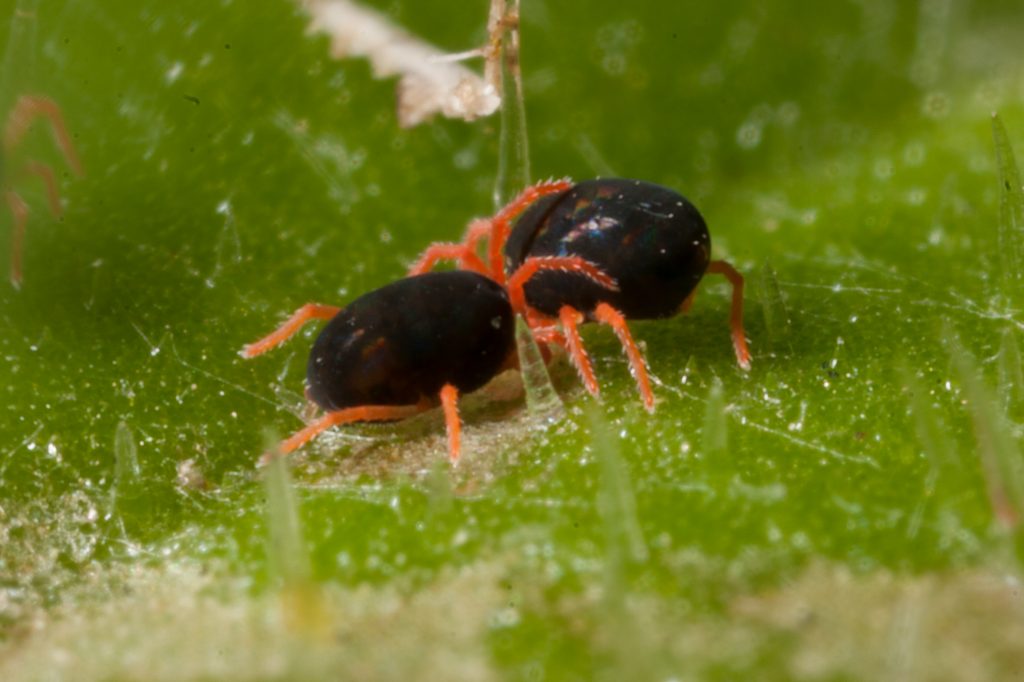To reduce redlegged earth mite risk in next year’s emerging crops, it may be necessary to consider TimeRite® now. But how do we know when a paddock warrants management?
Understanding redlegged earth mite risk is key in making decisions surrounding the implementation of TimeRite® on your farm.
In this article we explain when and how TimeRite® should be used as part of an effective redlegged earth mite management strategy.
The importance of reducing diapause eggs in spring
The redlegged earth mite (Halotydeus destructor) is a common and widespread winter pest of pastures and most broadacre crops. But most impacts are restricted to early plant growth stages when the diapause eggs which were laid last spring hatch. Egg hatch in autumn is triggered by cool, wet conditions (Figure 1).
The diapause eggs laid in spring are extremely tough, which enables the local mite population to persist in the soil into the next growing season. Over the warm summer months, these mites are inactive, and exist as diapause eggs to avoid the heat and lack of food.
In paddocks with high risk of redlegged earth mite damage, or a history of heavy redlegged earth mite loads, spraying might be required, and timing is key. TimeRite® is a tool that predicts the best date for spraying in spring to limit the number of diapause eggs produced, and therefore reduce redlegged earth mite abundance the following autumn.

Figure 1. The biology of the redlegged earth mite. Illustration by Dr Elia Pirtle, Cesar Australia
What is my risk of redlegged earth mites?
Spring spraying using Timerite should only be used if the risk of redlegged earth mite impacts in the next season are high as overuse of pesticides is seeing redlegged earth mite develop resistance to insecticides across Australia.
There are several factors to consider when predicting whether the redlegged earth mite will be a problem in a paddock. Redlegged earth mite risk varies according to a range of factors including crop rotations, weed coverage, redlegged earth mite abundance in previous years, and insecticide usage.
Examples of factors that can contribute to a high-risk situation heading into next season include:
- The paddock is currently legume dominant pasture, medics, or canola
- Next season the paddock will be a legume dominant pasture or canola
- Broadleaf weeds (particularly capeweed) are common in the paddock, or at the paddock edges
- Paddocks with high density / thick canopy growing late into spring creating an ideal environment for mites
- High numbers of redlegged earth mites have been common in the paddock
The severity risk for a given paddock can be calculated using the assessment tool featured in the ‘Redlegged earth mite: best management practice guide’ available for download through the GRDC website.
The team at Cesar Australia have developed an online, interactive risk calculator based on this best management practice guide which can be used to predict your risk.
Non-chemical options
The use of non-chemical options methods for redlegged earth mite control may be sufficient to keep populations small and at low risk.
Such options include avoiding sowing highly susceptible crops (e.g. canola) into pastures or paddocks known to contain high mite numbers, and where practical, rotating paddocks with non-preferred crops (e.g. chickpeas and lentils).
Undertaking weed management (particularly broadleaf weeds) or heavy pasture grazing in spring can also help to reduce mite numbers the following autumn.
If sowing susceptible crops in higher risk paddocks in 2022, early sowing can help to avoid damage because plants will be established by the time the redlegged earth mites hatch.The burning of stubble prior to sowing is also known to destroy diapause eggs.
Strategic spraying using TimeRite®
TimeRite® is a tool which uses environmental data – primarily day length – to predict when diapause eggs are likely to be produced in spring. The tool provides a location specific date for when spraying should occur (if necessary).
Spray times are based on a period within the season when redlegged earth have stopped laying winter eggs and before they start producing their summer diapause eggs.
The date for spring spraying is unique to each property and remains constant from year to year.
A current GRDC project aims to enhance the TimeRite® model, ensuring the continued accuracy of predicted dates in light of changing climatic conditions that may result in shifts in diapause timing and thus control outcomes.
It is recommended that spraying be carried out within the two-week period before the optimal date. If spraying is carried out two weeks after the optimal date, it is much less effective and mite numbers the following autumn will be much higher. Exact dates are available through the TimeRite® model.
Some examples of the recommended dates are:
- Birchip VIC – 14 September
- Horsham VIC – 23 September
- Bendigo VIC – 28 September
- Wagga Wagga NSW – 29 September
- Cootamundra NSW – 14 October
- Benalla VIC –12 October
- Hamilton VIC – 15 October
Timerite® is not designed for other pasture and crop pests such as blue oat mites, Bryobia mites and Balaustium mites, or lucerne flea and will not be effective against these species. Correct identification of mites and other pests is a critical first step before considering if Timerite® is appropriate this spring.


While TimeRite® continues to remain an effective strategy in many high-risk situations, it nonetheless relies on broad-spectrum pesticides, which disrupt populations of beneficial insects and cause pesticide resistance issues.
Therefore, it’s important to also incorporate non-chemical control options and not to rely on annual, routine spraying. Growers are advised to spray only if they need to. If chemical use is warranted, make sure to rotate pesticides with different modes of action as best as possible.
Growers and advisers can also refer to the Resistance management strategy for the redlegged earth mite in Australian grains and pastures to inform their management practice and reduce the evolution resistance in local mite populations.
Cover image: Illustration by Elia Pirtle





